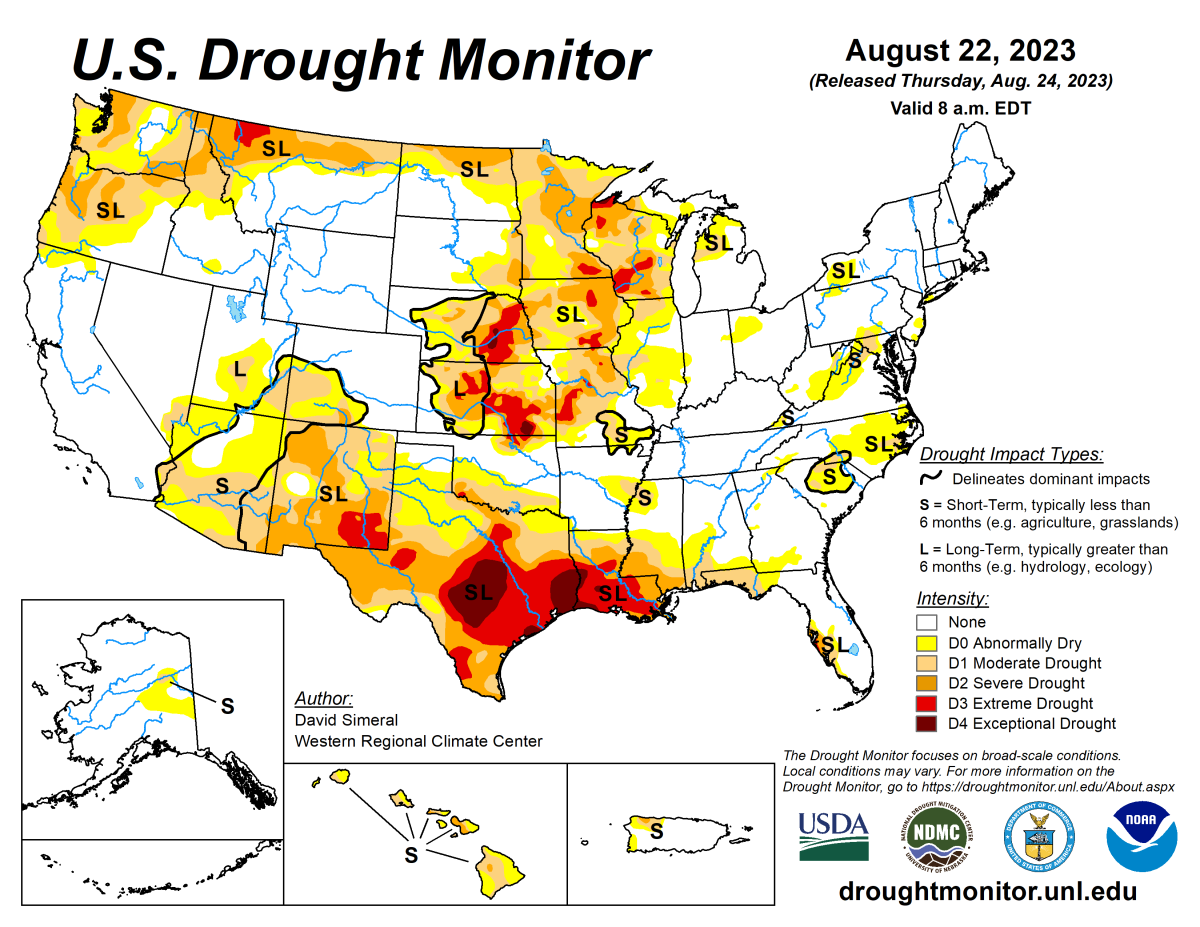
According to the August 22, 2023 U.S. Drought Monitor, moderate to exceptional drought covers 27.5% of the United States including Puerto Rico, an increase from last week’s 25.9%. The worst drought categories (extreme to exceptional drought) increased from 2.6% last week to 4.8%.
The upper-level circulation over the contiguous U.S. during this U.S. Drought Monitor week (August 16–22) continued to be dominated by a strong ridge of high pressure. Weather systems moved along the periphery of the ridge along the West Coast, then along the U.S.-Canadian border. A trough along the West Coast pulled in Hurricane Hilary from the eastern tropical Pacific. As she weakened to a tropical storm, Hilary dumped flooding rains across parts of California and Nevada and brought cooler-than-normal temperatures. Above-normal precipitation spread across those states and parts of Arizona, Utah, Oregon, Idaho, and Montana as the remnants of Hilary tracked northward.
Tropical Storm Harold was directed across the Gulf of Mexico along the southern periphery of the ridge. Harold brought rain to far-southern Texas as this USDM week ended. Cold fronts moved across the eastern third of the contiguous U.S. along the eastern periphery of the ridge. As they were mostly dry fronts, very little rain occurred, though they did bring cooler-than-normal air to the Ohio and Tennessee Valleys and parts of the Great Lakes and Northeast. For most of the nation from the Rockies to the East Coast, dry weather prevailed beneath the expansive ridge.
The week ended up warmer than normal across the West Coast, Pacific Northwest, and northern Rockies to Gulf of Mexico coast, with the relentless heat wave continuing across the South.
Drought or abnormal dryness contracted or was reduced in intensity in areas that were wetter than normal, primarily from southern California to the northern Rockies, and in the eastern Great Lakes. But drought or abnormal dryness expanded or intensified where it continued dry, especially from the Southwest to central Gulf of Mexico Coast and parts of the Mid-Atlantic, northern Montana, the Upper Mississippi Valley, and Hawaii.
Nationally, expansion exceeded contraction, so the nationwide moderate to exceptional drought area increased this week. Abnormal dryness and drought are currently affecting over 111 million people across the United States including Puerto Rico—about 35.9% of the population.

The full U.S. Drought Monitor weekly update is available from Drought.gov.
In addition to Drought.gov, you can find further information on the current drought on this week’s Drought Monitor update at the National Drought Mitigation Center.
The most recent U.S. Drought Outlook is available from NOAA’s Climate Prediction Center. The U.S. Department of Agriculture’s World Agriculture Outlook Board also provides information about the drought’s influence on crops and livestock.
For additional drought information, follow #DroughtMonitor on Facebook and Twitter.



